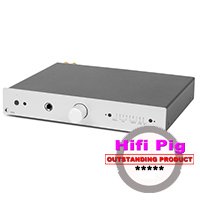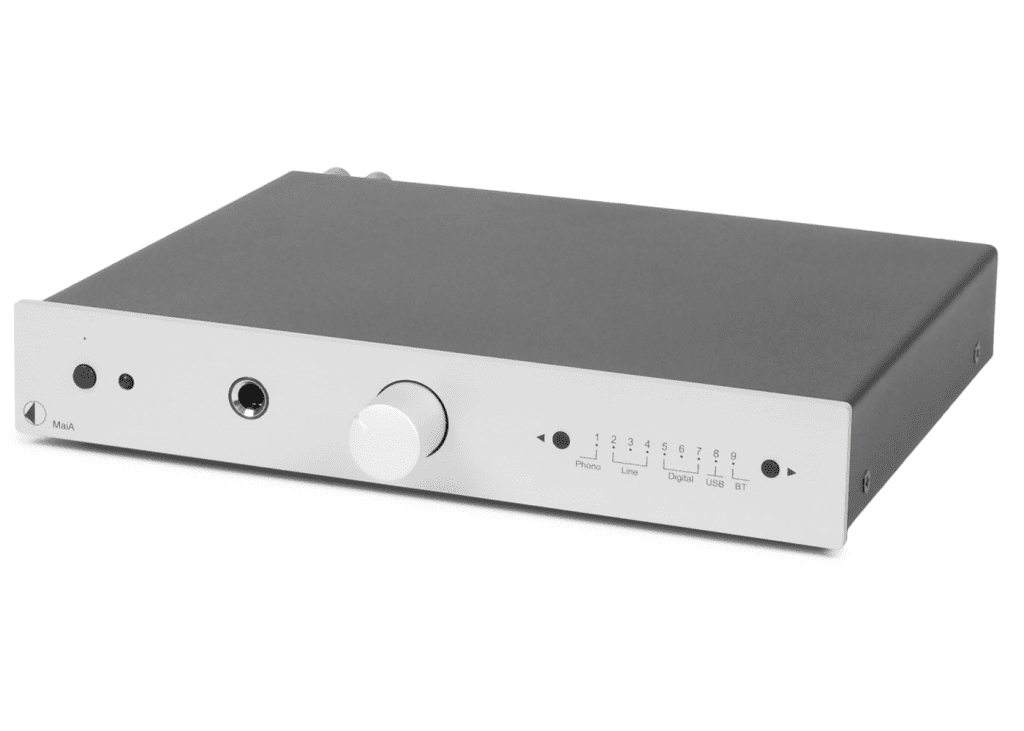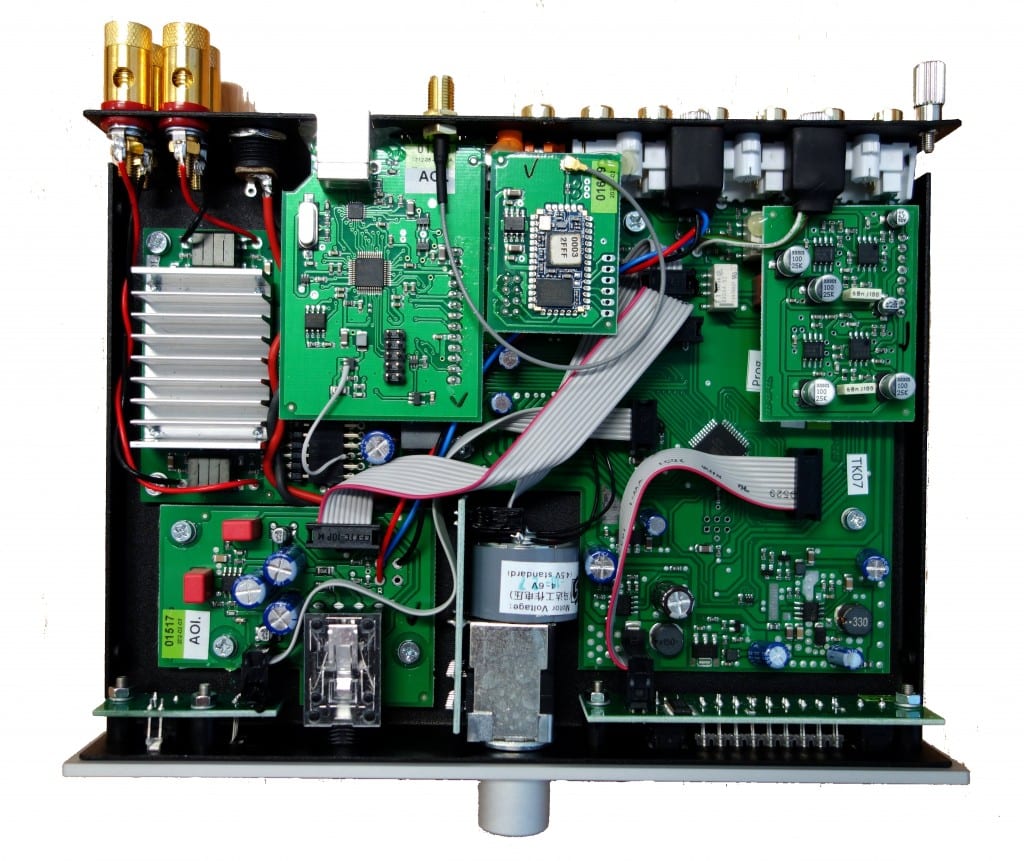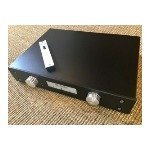They say that size isn’t everything, or big things come in small packages, so let’s see if those statements hold true with 
the amplifier under review here – the Pro-Ject MaiA.
CONSTRUCTION
This really is a diminutive amplifier by anyone’s standards and I can easily see it fitting unobtrusively into countless domestic situations. Measuring some 206mm(W) x 36mm(H) x 200mm (220mm including speaker sockets) deep and weighing not far off a kilogram, excluding the power supply. The separate power supply seems to be a generic design which provides 20 volts of DC at 3 amps and is fitted with a dual pole plug that connects it with the power inlet socket on the rear of the amplifier, with the power input to the supply via a standard UK 3 pin mains plug. Other plugs and voltage matching power supplies are available for non-UK consumers. The casework is of steel construction with the choice of either a black or silver finish faceplate. Fit and finish of the casework is exemplary.
When it comes to source inputs, there is an absolute plethora available, with an impressive NINE separate digital and analogue inputs to choose from. Rarely seen these days although we are seeing a huge revival of vinyl playback, is an RCA phono input that caters for moving magnet or high output moving coil cartridges only, followed by 3 line level analogue inputs labeled 1, 2 and 3 accordingly, then on to the digital inputs which comprises 2x TOSLINK sockets, an RCA co-axial digital input, a USB input and a Bluetooth connection to APT-X standard, with a supplied external aerial which screws on to a dedicated socket on the rear panel.
There is only provision for a single pair of speakers to be connected. The group of four 4mm connectors are grouped tightly together at the far right of the rear panel and not insulated from each other either, plus the holes to insert bare wired cables are aligned vertically so extreme care is needed so the wire isn’t pushed right through the connector body to touch the adjacent terminal above or beneath. A good tip would be to measure exactly how much bare wire is exposed on the cable to be inserted that is less than the connector’s diameter, so none of the bare wire is exposed external to the connector to negate the risk of shorting. I would not advocate or even contemplate using spade connectors for the speaker connections because of the close proximity of the naked terminals.
On the front panel reading from left to right, we have a power button with a tiny blue LED above. A real surprise was to see the amplifier perform a soft start operation with the LED blinking while it is being carried out, so no switch on or power down thumps through the speakers from this amplifier, which is rather refreshing to see. Next we have the remote control window which is a small unobtrusive plastic dome, followed by a 6.3mm headphone socket, which mutes the speaker output when a headphone jack plug is inserted. We then have a rotary volume control knob to adjust the volume by hand, although the control itself is also motorized for adjustment via the remote control handset. The control itself is quite stiff to turn by hand, although in all probability this stiffness will ease over time with usage. The remote control handset provides the basic functions of source selection, volume adjustment and power on/off. Next on the front panel of the amp we find a source selector button which changes the source in upwards increments, with a bank of blue LEDs to indicate which source has been selected and screen printed in white lettering beneath those LEDs is the source names themselves, then finally another source selector button to change the source in downwards increments. Incidentally, the front panel LEDs are very small yet still bright, but don’t actually provide much glare as blue LEDs are prone to do. You can tell the power is applied and which source has been selected without constantly drawing your attention to them – a nice touch.
I have a policy whereby I don’t get the tools out to investigate the internals of any component submitted for review, but sometimes I still get curious about the goings-on inside things as an integrated amplifier with motorized volume control, a phono stage and a DAC crammed into such a small enclosure I would imagine would be pretty well packed. I gave in to temptation this time and found that there wasn’t a lot of fresh air to be found inside the chassis, as you can see.
Power output is provided by Flying Mole modules and said to be 2x 25w into an 8 ohm load and 2x 37w into 4 ohms (both channels driven) although not confirmed by objective measurements myself. The integrated DAC uses a Cirrus Logic CS4344 24bit/192kHz multi-bit Delta Sigma type.
Price at date of test circa £399.00
SOUND QUALITY
Unlike a standard run-of-the-mill integrated amplifier review, I had my work cut out with this one as it wasn’t just a case of bunging a CD player into it and any old pair of speakers and cables for the output either. If the inputs were there, they all had to be tested which proved to be quite a lengthy and protracted process, made more complicated by my lack of real enthusiasm for computer based source material. Not only that, I had to fit the amplifier into various systems ranging from high end to budget, including ancillaries so hopefully you the reader can get a handle on it’s performance envelope.
Firstly, I paired the MaiA with my HTC mobile phone using the Bluetooth facility and this was straightforward and easy to do when following the instructions given in the user manual. Select the “BT” source on the front panel, and then set the phone to detect any nearby devices and when the BT LED on the MaiA flashes, momentarily press the power button on the MaiA and job done with no need for passwords. I only have a small selection of MP3 tracks on my phone, but the sound quality was perfectly acceptable nonetheless given the limitations of the MP3 format. I have Spotify on my tablet PC and the sound was again perfectly acceptable from that source.
Next, I connected the MaiA into a TEAC AH300 series midi sized component music system using the TEAC CD drive and a pair of Eltax bookshelf speakers. There was a huge increase in sound quality over the TEAC amplifier and really did get hold of the Eltax speakers, producing a crisper more powerful and lucid sound. The overall sound quality was somewhat let down by the woolly sound from the TEAC CD player, but still a worthwhile exercise nonetheless because it told me just how far class D chip technology has advanced in recent years compared to the TEAC which I believe (correct me if I am wrong) has Tripath based amplification.
By good fortune, I had a pair of Acoustic Energy 101 bookshelf speakers to hand which had also been submitted for review here at Hifi Pig and they seem like the genre of speakers that would very likely be paired with the MaiA, being of modest dimensions and pricing, so they were coupled up to the MaiA with my resident CD player performing front end duties. With a more accurate and realistic signal being fed into the amplifier, I was stunned at just how good this little amplifier sounded. Delicious treble performance which was clean and vibrant, the sound of struck cymbals were as realistic as anyone could wish for, with a defined metallic “ting” and the following decay all clearly rendered. Mid tones were slightly on the lean side giving a slightly cool balance to the sound. Of course, I didn’t expect the bottom octave to be forthcoming from the Acoustic Energy 101s due to their size, but even so that absence wasn’t missed because what bass was there I found to be very solid and articulate, full of expression and energy, well defined and textured. Placing the speakers on stands and close to the rear wall elicited an increase in bass output but that to me added a small booming effect, so I preferred them out a bit into free space, around 3 inches was optimum for me personally. They were equally at home on a desk surrounded by computer paraphernalia, so placement isn’t critical, aided of course by being front ported for the bass reflex. The performance of the Acoustic Energy 101s has already been detailed in a separate Hifi Pig review. Incidentally, I heard this same pairing fed with a Pro-Ject turntable at the recent Bristol Hi-Fi Show and they sounded extremely good , even with a room for of people chattering among themselves.
Back to the sound then of the MaiA/AE 101 pairing, I found it a very entertaining listen and happy to say that I was never affronted by what I was hearing, or never once thinking to myself “Wish there was more bass, better mids, clearer treble, etc” because it simply wasn’t the case. Fink’s “Sort of Revolution” CD sounded palpable and full of detail, the propulsive bass line being recreated very well indeed and the treble especially so, that “ting” from the Ride cymbals in all the tracks never being overwhelmed by the rest of the music so it stood as an individual clear entity. This album is threaded throughout with close mic’d acoustic guitar recorded so the body of the instrument needs to be captured and the squealing of the finger work on the frets is integral to the performance, adding not detracting from the charm of the album.
Time now to really put the MaiA through it’s paces with my resident system CD player, speakers and cabling. The speakers are medium efficiency infinite baffle designs on rigid spiked stands, situated in a smallish listening room so the amplifier won’t be expected to fill a huge room with sound and the purpose was to try and find the upper limits of the MaiA’s capabilities. Cabling was by Audiomica in the form of the ERYS Excellence interconnect and the CELES Excellence speaker cable (Reviewed elsewhere in Hifi Pig). Now I found that the MaiA wasn’t seriously outclassed at all with every component costing many times more than it did. The sound moved on into yet another dimension that was snapping at the heels of my resident amplifier which cost some 10 times more than the MaiA. Yes it didn’t have the raw grunt and outright power at higher volumes, but even so it says more about the MaiA’s capabilities and what can be achieved with good design that enabled that. On that note, I can easily imagine that someone will design a more powerful low noise power supply unit to replace the supplied stock one and perhaps give the amp a bit of a turbo boost to aid performance.
Back into the CD drawer went Fink’s “Sort of Revolution” and here we are talking about differences between the two amplifiers in the finite range, they were that small. Bass was 85% of what my resident amplifier gave me, treble was even closer and it was much easier now to pick up the ambience cues in the recording , but it was the mid band was where I heard the greatest difference and the MaiA provided a slightly “leaner” sound, but even that I could probably have lived with on a daily basis without real criticism in the long term, because that is a better compromise than a flabby or chesty sounding midrange.
Imaging and soundstage were certainly well up to standard with good height and depth, the sound extending well out beyond the speaker boundaries.
When the amp was paired with the AE speakers that last octave of bass was certainly curtailed, with my resident speakers however bass extension went much lower and with taut power which suggests a high damping factor for the MaiA. The MaiA didn’t quite have the same “punch in the guts” bass power and dynamics that my resident amplifier has and frankly didn’t expect it to be, but I don’t see that as a weakness on behalf of the MaiA. Turning the volume control right round until 2 o’clock and it all held together really well with no muddling or instruments crashing into one another as the volume level went up. Bass grip was extraordinary for what is deemed as a low power amplifier rated at 25 watts into 8 ohms. By about 3 o’clock on the volume however the sound started hardening up and although I could detect no clipping or any other distress at all I didn’t risk taking it any further, because by then the listening room was full of sound anyway and so my test objectives were met in full. Incidentally, the casework didn’t even get the slightest bit warm during these high power runs. A highly commendable performance.
I had to borrow a turntable as I am ‘in between’ turntables at the moment. A friend loaned me a Thorens TD160B with a Grado Prestige Black cartridge to evaluate the MaiA’s phono stage. I found no hisses or hums through the phono input and it had sufficient gain to match the analogue line inputs. Sound was clean and rather lively I thought, although I couldn’t tell for sure if it was the Grado cartridge or the MaiA amplifier responsible. I am out of my comfort zone whenever I use components for evaluation I am not wholly familiar with, so will leave it that I found no immediate causes for concern.
Last, but by no means least, I turned to the digital input capabilities of the MaiA. Both co-axial and optical inputs routed from my CD player in to the MaiA’s DAC were more than satisfactory with no noise or mush detected. It was nigh on impossible to tell if the resulting sound via the DAC was any better or different to the DAC within my resident CD player because they sounded so similar. Signal lock was instantaneous although there is no indicator to show that it was. USB connection from my laptop PC was of a similar performance so no quibbles there either. As my television and satellite receiver are in another room unfortunately, so I was unable to test how the MaiA interfaced with that equipment although I foresee no issues there either.
CONCLUSION
My opening statement to this review asked whether size isn’t everything and if big things come in small packages, so do these statements apply to the Pro-Ject MaiA amplifier? The answer has to be a resounding “yes” by anyone’s standards and even now I am still astonished at how much performance can be crammed into such a small box, which also happens to suit modern lifestyles with it’s abilities to become inconspicuous. A good solid 25 watts per channel of clean sound, three line level analogue inputs, a moving magnet level phono input, a headphone output too, no less than three digital inputs and a Bluetooth connection as well, adds up to a versatile and highly flexible heart to any hifi music reproduction, computer, or two channel A/V system, provided of course that reasonably efficient speakers are being used and in a room not exceeding 25 square metres unless near field listening in a larger room is envisaged.
It will happily integrate into budget systems, middle ranking systems and not entirely out of place or embarrassed when rubbing shoulders with the esoteric either, although there are some inherent limitations like power output which is not entirely unexpected at the sort of level we are discussing here. What available power is there, is clean and enjoyably listenable, free of fatigue and distortion.
The icing on the cake has to be that sub-£400 price tag and that to me ranks it as a complete steal in terms of sound quality over value for money. I am confident it will win many admirers.
Construction: 9.3/10
Sound quality: 9.4/10
Value for money: 9.6/10
Overall: 9.4/10
Recommended for: Any music system where high power demands are not a primary requirement. Will interface with just about anything that churns out music – in whatever format, analogue or digital.
Dominic Marsh
With a score exceeding 8.5 overall for the MaiA amplifier from Dominic’s review above, we now hand the same amplifier over to Dan who conducts the follow-up below:
From the very first chord that strummed from the Pro-Ject Maia, I was hooked! The small intricate delicacies that the little multi analogue and digital input amplifier presented was incredible, I was warned by Dominic that this amp is ‘a little sweetie’ and my oh my was he right.
Class D amplification, coax, optical and USB inputs as well as a handful of analogue inputs including a MM Phonostage, 3.5mm input for a portable player or phone and a 3.5mm output to pass a signal to active desktop/computer speakers and a bluetooth aerial for streaming from a PC, phone or tablet!
How do Pro-Ject do it? No really…how do they do it? A price tag of £399 would have suited me just fine if this was a simple analogue based input class D amplifier that p doused such engaging tones as the Maia.
Getting on to its class D amplification, the Maia doesn’t sound cool, cold, limp or lacklustre. The musicality that simply effortlessly flows from this magicians box of tricks was driving my big Ayons sweetly, let alone a few little speakers I have to hand. The power output is rated at 25W into 8 Ohms and 37W into 4 Ohms. My Ayons are 6 Ohm so we can assume a good 30W was available for them. The Maia is claimed to have a drive capability of 2 Ohm loads. I’ve had some strong contending A/B amplifiers here just recently that don’t come anywhere near the Maia’s ability to convey such micro details at lower levels with a background blackness that is just so dead each small nuance sounds simply eerie. All of this from a nasty switch mode power supply. A good linear with plenty of headroom would no doubt give more drive and attack and may well support the intentions put forward that the Maia is capable of dipping to 2 Ohms comfortably.
The MaiA was connected to my own personal Pro-Ject Stream Box DS Net via its coaxial RCA output for most of my listening. I have ordered a custom made 9v PSU for this from Paul Hynes as Pro-Ject’s own multi rail linear PSU is for their 20v based equipment which the Maia is (I have also been informed that a complementary Maia linear power supply is due soon) so I think for my own piece of mind when my 9v arrives from Paul I will get a Pro-Ject Linear PSU from Henleys the UK Distributer and try the Maia once more and attach a small update to this review as the intrigue in me is very high due to the current unexpected performance I’m getting currently.
Another point really worth mentioning which can be somewhat of a big deal is the remote controls ability to control the amplifier from all sorts of different angles and even working around objects even though it’s signal is infrared and not radio frequency. I’ve been in torment just recently with a couple amps that, although I don’t mind getting up and twisting the knob manually, if your going to provide a remote for the love of God make sure it can be used at more than one degree of axis! So thank you Pro-Ject for restoring my faith in simple engineering!
I don’t use a turntable but I have various sources which have analogue outputs and also some active desktop speakers which the Maia dealt with admirably once again, conveying a sound which was detailed and truly musical.
The bluetooth feature worked well, sound quality may take a little hit here but keeping to streaming good quality files allows one to quickly forget about any slight dip in performance and simply enjoy the flexibility of the technology and ease of use.
CONCLUSION
All in all the Pro-Ject Maia is the first true budget All in One amplifier that truly demands an audition. It’s so compact and feature rich it can adorn any room of the home and the Stream Box Ds Net I use is the same width, they just sit on top of each other as would the other Pro-Ject components, so whether you want to play a CD from the matching form factor CD Box S or the taller CD Box DS,mlisten to Internet radio or stream there is a compact solution that will drive loud volumes of any speaker 90db or above and below that threshold to most reasonable levels.
Treat the Maia with respect regarding its power output and the results are truly great, push it too hard and it I’ll bite back.,
Don’t be afraid to add something a little more expensive on the end of Maia as it will only benefit the overall experience this little amp is a bit of a show off.
Build Quality – 9/10
Sound Quality – 9/10
Value For Money – 9.6/10
Overall – 9.2/10
Recommended for ‘True value for money’ a one stop shop with a sound quality that just makes you sit back and smile.
Dan Worth



























































































































































































You must be logged in to leave a reply.